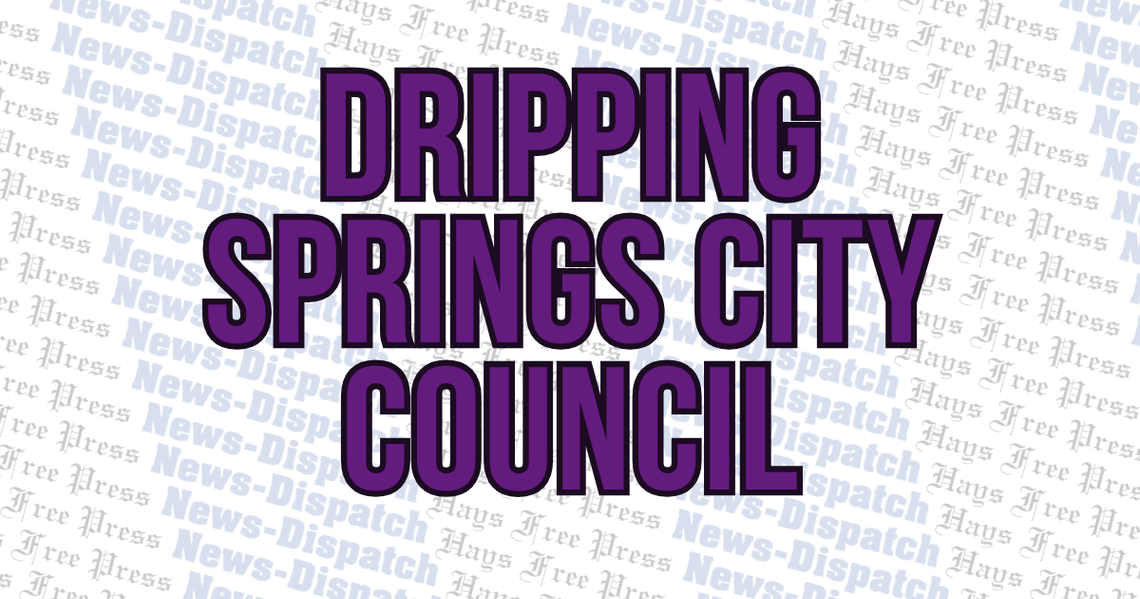DRIPPING SPRINGS — New and updated wayfinding signs are closer to reality after Dripping Springs City Council voted 3-2 to move the bid package forward.
The city found that there was a need for a more cohesive wayfinding signage system to enhance visitor experience, support local businesses and improve traffic flow and connectivity. According to People & Communications director Lisa Sullivan, a well-designed wayfinding program will help guide residents and visitors to key destinations throughout Dripping Springs, including city hall, the Visitor Center, historic Mercer Street, parks, trails and other sites.
City staff has been working with Studio 16:19 on the design and implementation of the signs. Multiple questions were asked during the July 15 city council meeting, leading council to ultimately table the item. Therefore, a wayfinding committee, composed of council members Taline Manassian and Sherrie Parks, along with city staff Michelle Fischer, Pam King and Sullivan and Jonathan Wagner from Studio 16:19, met July 25 to go over questions and review options.
Sullivan brought back additional information from the committee to city council during its Aug. 5 meeting.
Visibility
The first question that arose from council was if the green color of the signs — which is where the text would be displayed — would be visible enough at night and if it’s reflective.
The entire front sign face, including the text, background colors and logo design is noted to be printed with retroreflective sheeting per plans and Texas Manual on Uniform Traffic Control Devices (TMUTCD) code, according to Sullivan’s presentation. The designs and locations have been reviewed and approved by the Texas Department of Transportation (TxDOT) and “we know they would not have approved them if they were not visible at night.”
Council also asked if the green could be made dark blue, essentially swapping out the background color and the color behind the text. The original design includes all the brand colors — dark blue for the night sky, light blue for water and Dripping Springs and green for the Hill Country.
“We created different versions and showed it to the committee of removing all the green and just having blue. The committee decided to keep the original design. The reasons being the sign will be seeable at night,” Sullivan said. “The original design was also designed to complement the parks and when we removed all of the blue, it made them look too dissimilar.”
Height
Along with colors and visibility, council was initially concerned with the proposed height of the signs.
The sign size is determined by the six-inch letter height requirement and the destinations being shown. Per TMUTCD and TXDOT guidelines, six-inch minimum lettering is required for legibility in a vehicular context, Sullivan said. Clearance height of a roadway sign must also be seven feet from the bottom of the sign to the elevation of the edge of the roadway, so that someone walking near the sign won’t run into it, Sullivan explained.
All the existing roadway signs in the city, within the TXDOT right-of-way, abide by these guidelines: “While the scale of the drawings looks, ‘Oh my gosh,’ when you look at them on the road, [at a] pedestrian scale, these signs may appear large, they are scaled appropriately to a vehicular scale with the surrounding context,” Sullivan said.
Look and feel of downtown area
Council also felt like the signs did not fit with the look and feel of the downtown area of Dripping Springs, but signage placed along the roadways must comply with TxDOT regulations.
“The signage we have in the parks and other signage we may see on city streets, that does not have to abide by TxDOT regulations, so they can be visually different,” Sullivan said.
The city is limited on what it can do with these signs, thus not being able to choose a more creative option.
According to TxDOT and TMUTCD guidelines, all post-mounted roadway signs are required to be supported on a breakaway/slip base. This is a safety feature that allows signposts to break away from their base if a vehicle crashes into them, minimizing the severity of the crash. Based on the city’s previous experience and research, there are limited types of poles that are designed to fit into the breakaway base — the city has opted to use the recommended schedule 80 post, per the TXDOT detail, with a black powdercoat/paint to provide a more polished finish.
Council discussion
The scope of the project includes a bid for 20 signs — with the possibility to do it in stages — with an estimated cost of $7,000 per sign based on comparables, with half in the fiscal year 2025 approved Hotel Occupancy Tax (HOT) budget and the other half in the drafted FY 2026 proposed HOT budget.
Starting off the discussion across the dais, council member Geoffrey Tahuahua asked if there was any consideration amongst the wayfinding committee on cost or materials of value engineering. As he was researching the proposal more, he found that $7,000 per sign seems "really high."
“The existing signs, which are produced by TxDOT and their vendor, are, my guess would be, a third of the price,” he said.
Manassian said, to her recollection, the committee did not discuss the cost, but only if they were compliant with TxDOT because that was the answer to many of the questions that were asked by city council during the initial proposal.
“My understanding is that is part of the next part of the process,” said Parks.
Sullivan said that with the bid process, the cost could come out to be less than $7,000 per sign, but the reason she put that number is because that is what Studio 16:19 said based on a recent project they worked on.
Mayor Bill Foulds said he wants to make sure that the city goes above and beyond for contractors to look at the project, ensuring that there are multiple people vying for the bid.
Tahuahua added to his previous point that council should be taking other things into consideration when discussing the budget of the wayfinding signs, alluding to the request that Dripping Springs Ranch Park staff brought up earlier in the meeting with needing funds in the FY 2026 budget for roof repairs.
“I recognize that staff has spent a lot of time on this and I do trust that Studio 16:19 is giving us a reasonable guestimation,” he said. “Given the budgetary constraints that we are having, and I know we are proposing pulling this out of HOT, but let’s say it does come back at $7,000 a sign, $140,000, that takes care of a one-sixth of [the] roof over at [Dripping Springs] Ranch Park, which I would argue is a lot more critical of a need, especially for a revenue-generating facility, versus something that just looks nice.”
Tahuahua continued to state that if the city had a budget “where we can afford to look at things that look nice, that’s a different conversation, but I feel like the budget discussions we’ve been having the last couple of weeks, we need to be looking at tightening the belt and this just feels — and I recognize this is just to bid it out — wildly inappropriate for us to look at something like this, considering at even the $7,000 a piece, that’s $140,000.”
Manassian said that while she does not disagree with Tahuahua’s sentiments, she said that the signs do more than just look nice, they also direct people to different parts of town, benefit the local businesses and help people discover what Dripping Springs has to offer more than what can be seen driving along US 290.
She added that council will look and assess the bids when they come in, but she does not want to immediately dismiss them if they come in at $7,000. At that point, council could ask questions to see what alternatives could be considered.
“We are doing this because of demand. We’ve heard this for years. We’ve heard this feedback from the Visitors Bureau. We’ve heard this feedback from the chamber,” she explained. “So, I think it’s an important thing to consider and I would just sort of say, ‘Let’s wait and see what the numbers are and then, figure out where the money should be best spent.’”
Council member Travis Crow said that he thinks council should see where the bids come out at, but he also agreed with Tahuahua about the cost of the signs.
Foulds said that they are in a position where they need to make sure funds are distributed to preserve what the city has and then, drawing in for new things: “I saw what happened to our last county building and it literally fell apart and that’s how we got DSRP. When I see pictures of a roof leaking, it brings back some very bad memories of what our county did 20 years ago, so I don’t want to let DSRP get into that.”
Ultimately, council voted 3-2 to authorize the issuance of a request for proposals for the wayfinding signage package, with Tahuahua and Crow dissenting. The bid package will be on the Sept. 16 council meeting agenda for possible approval.
To listen to the full Dripping Springs City Council Aug. 5 meeting, or look at the agenda packet, visit www.drippingsprings-tx.municodemeetings.com.











